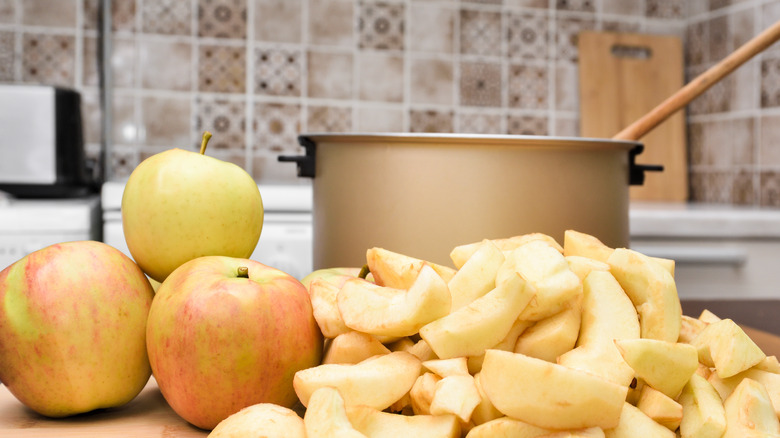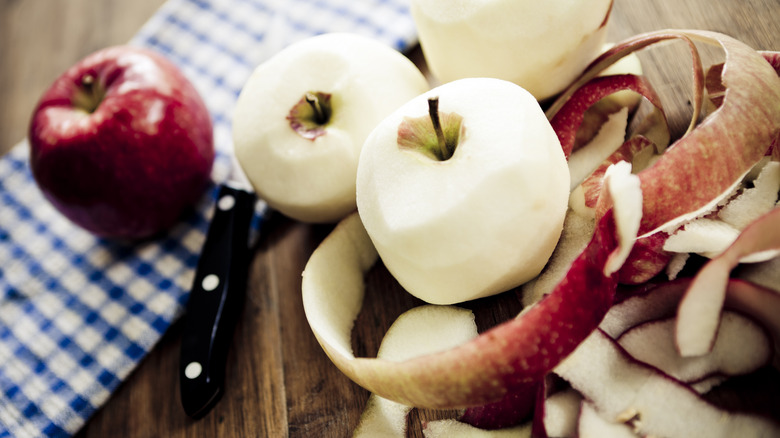What Is Apple Stock And How Do You Use It?
A stock is the concentrated liquid produced from simmering various foods in water. This intensely flavorful and versatile ingredient is at the core of so many dishes, from soups to stews to sauces and more. And while typically, this refers to vegetables like mushrooms or tomatoes, or proteins like beef or chicken (for stock, that means the bones, while broths simmer the meat), it's possible to make these near-magical elixirs from fruit, too, and an apple stock is one very delicious and surprising example.
Another French term for stock is fond, meaning "foundation," so it's no surprise that these super adaptable liquids are the basis upon which so many meals are built. Use apple stock in place of water for cooking rice or beans, pasta or other grains. Keep it on hand to add moisture to braised pork, chicken, or beef, or use in place of water or other broth to create a creamy soup like a seasonally inspired butternut squash and pear bisque.
Stocks are ideal for rejuvenating leftovers, or as a cooking liquid when sauteing or stir-frying, too, so this apple version presents opportunities to add autumnal essence in a ton of applications. It's even possible to turn stock into a glace by further reducing the finished stock by about ¾ for a thicker version that more closely resembles a syrup (with none of the added sugar) that can be added to cocktails in place of simple syrup or drizzled over a glazed pork chop instead of maple.
From almost trash to sweet treasure
Making apple stock is just a matter of saving up apple peels, ends, or bits that go unused and simmering these potentially otherwise wasted elements in water a few times over the course of a few days, until you have a reduced liquid bursting with autumnal goodness. It's also possible to leverage the fruit's natural pectin to create a basic pectin stock, which is used in the making of jellies. It's a little less intense but faster to make and useful in many of the same applications.
Apples have all kinds of wonderful flavor partners that can amplify your stock, too. Spices like clove, cinnamon, allspice, cardamom, and ginger, and herbs including rosemary, marjoram, tarragon, thyme, sage, and basil, are all simple to infuse into your stock by simmering together in cheese cloth or a sachet that you can remove easily when you're through. (Just be aware of your timing; you'll want to add herbs and spices toward the end of the process, as in some cases they can become over-extracted and bitter, or lose flavor entirely in others.)
Citrus is also a welcome addition, and a few orange or lemon peels add a beautiful brightness to your apple stock. You can even skew toward a more savory profile with fennel, garlic, onion, mustard seeds or hot peppers like jalapeño, making the stock an easy and ideal compliment to an impressive, super-tasty main dish worthy of a holiday table, or a weeknight dinner.
Selecting apples for your stock
Given that stock is a concentrated expression of an ingredient, this is a fun chance to try experimenting with different apples, so you can get an intensified dose of their flavor and determine the best use for your liquid. Try going with a different variety each time you make a stock — considering the U.S. alone produces over 200 varieties of apples, that could keep you busy for a while!
While regional varieties are abundant, a few classics are available in most parts of the country that would work well in a stock, and give your finished product a distinct personality. A gala apple, for example, has notes of vanilla, while a honeycrisp boasts more of a sweet-sour flavor profile. Fuji tends to be a bit floral, while the iconic green Granny Smith is well-known for its tartness.
Since apple stock is designed to use scraps and lesser wanted elements of the apple, you don't need to pick the most pristine fruits from your farmer. It's okay if your apples are a little bruised, misshapen, or not quite picture perfect in some way. They'll still have a chance to shine in your stock, and your guests will be grateful that you made very good use of every last bite.


